
DON’T BLOW THE SHOT OF A LIFETIME
Training, Equipment, Attitude. TEA Party Success!
By Craig Boddington
Life isn’t always fair. It’s possible to spend an entire lifetime of hard hunting and never get a chance at a truly fantastic, world-class trophy. It’s also possible to take a Boone and Crockett whitetail on the very first outing. The strange nature of hunting is that, while both effort and technique certainly count, ultimately there is a major element of random chance that places a great animal and a hunter in proximity at the same time.
So it isn’t just sour grapes to refer to any hunter who has taken a great trophy as a “lucky SOB.” Yep, sure was, and that’s a fact. On the other hand, let’s give credit where credit is due. Regardless of species, for every great trophy taken, there are at least as many opportunities that are blown, either through misses or failures to seize the opportunity.
Yes, luck was still a factor in placing a great animal in the unfortunate position of being in that hunter’s sights. But when that animal presented itself, Lady Luck walked away. In what the old magazines used to call “the moment of truth” there was very little luck involved. Whether by instinct or experience, anyone who has the good fortune to take a great trophy did things very well when that opportunity came along.
| Article continues below… Please support our advertisers!  … click opens in new window. |
In a fairly frenetic forty years of hunting I’ve taken a lot of game…but I haven’t had all that many opportunities at truly fantastic trophies. Nobody does. I’ve made my mistakes, but in the clinch, when opportunity and preparation must meet, most of the time I’ve done okay. I work pretty hard at being ready when opportunity strikes.
You could split it up lots of different ways, but I think there are just three key elements to making sure you are ready when Lady Luck smiles. In our current political environment it’s real easy to remember them sort of as if we’re going to a TEA party: Training, Equipment, Attitude.
TRAINING
We start with “t” for “training” for two reasons. First, in our entitled society it’s all too prevalent to believe that we can substitute technology for skill. Sure, equipment matters, and we’ll talk about that…but skill comes first, and there are no shortcuts to consistently good shooting. You have to work at it. Second, within extremely broad parameters, how well you shoot is far more important than exactly what you are shooting.
The first step is to have a good grasp of the shooting basics. I know of no better way to put it than how the Marine Corps marksmanship instructors teach it: The BRASS rule for “Breathe, Relax, Aim, Sight alignment, trigger Squeeze.”
You’re excited in the presence of game, and this is natural. You have to control the excitement, so take a few deep breaths while you’re settling into the rifle. Then relax, let the last breath halfway out, and aim carefully. Then you check one last time to make sure the crosshairs or sights are where you want them…and you squeeze the trigger. These days the vast majority of us hunt with scoped rifles—but it is invaluable to learn the shooting basics with an open-sighted .22 and thousands of rounds of cheap ammunition. Absent recoil and lots of noise, the .22 makes it very simple to concentrate on breathing, getting steady, and squeezing the trigger. If you achieve proficiency with open sights, shooting with a scope will always seem (and is) a whole lot easier.
No matter your level of experience, a .22 remains one of the very best tools for training and practice. The ammo is cheap and, more importantly, you can shoot all day long without negative effects from recoil. If you’re hunting with a scope, put a good scope on an accurate .22 and shoot it a lot; if you’re planning on using an iron-sighted rifle, perhaps a big bore you’re readying for Africa, shoot an iron-sighted .22 even more.
There is no real shortcut to the basics of rifle shooting…and there is no substitute for practice. Well, yes, there is: Field experience. But with short seasons, limited bag limits, and escalating costs it takes many years for most hunters to acquire a breadth of big game experience over a wide range of conditions. So we’re back to practice.
All too many American shooters spend their range time at the bench. The bench is essential for testing your rifle’s accuracy, and it isn’t bad for concentrating on those all-important shooting basics—but shooting from a benchrest is not practice for the field. For useful practice for hunting you have to get away from the bench and practice from actual shooting positions you might use in the field. Over time most hunters achieve the greatest comfort level from just a few shooting positions, which probably depends on the kind of hunting we do the most of. I’m primarily a western hunter and I always carry a daypack. So my greatest comfort zone is to put the pack over a rock or a log, rest the rifle over the pack, and sit, stand, or lie behind it depending on the height.
In Africa three-legged shooting sticks are almost universal because they’re fast and get you above low brush. Actually, they’re not just useful in Africa; I put a set in my gun case and take them almost everywhere—including to the range, where part of every shooting session includes shooting off sticks. They are probably my second most familiar comfort zone.
Many shooters rely on bipods and crossed sticks, and they’re great, too…but whatever you like to use, you must practice in order to gain the most stability. Speed is also important. Most opportunities at game animals are fleeting, so the quicker you can get into position and get steady the more successful you will be.
Regardless of your preferred position or shooting rest, there will be situations when it just won’t work. Sometimes things happen too fast, sometimes it’s impossible to get the height right. It’s okay to achieve a comfort zone, but you cannot be married to it. The more shooting positions you know how to use and can get steady in quickly the more successful you will be. The good old NRA competition shooting positions of prone, sitting, kneeling, and standing are all useful in certain situations, and all can be used (and practiced) both with and without support. Again, a good .22 is an invaluable tool for expanding the shooting positions you are comfortable with. I’m not talking about a crash course here; I’m talking consistent shooting from field positions over a matter of years. However, there are at least two good ways to cram.
While it does indeed take years to acquire a lot of field shooting experience on big game, varmint hunting is a fantastic opportunity. You can learn at least a decade’s worth of field shooting in a couple of days in a prairie dog town. Except: Forget the portable benchrests, and use field shooting positions. If you can get steady enough to hit prairie dogs consistently there is no big game animal in the world to be concerned about.
The other way is to go to one of the several good field shooting schools now available. I have attended both the SAAM (Sportsmen’s All-Weather, All-Terrain Marksmanship) Precision and Safari courses, conducted in the Texas Hill Country. Even this old dog learned some new tricks from some great instructors. If you’re the kind of guy who simply cannot make time for regular range sessions, or access to a range is an issue, think about summer varminting or getting some training.
EQUIPMENT
The best rifle in the world can’t make up for bad shooting…but it’s a heck of a lot easier to make a shot when you have the right rifle, cartridge, and sights! Clearly this varies from situation to situation, so it seems to me there are two schools of thought: Versatility, or specialization.
Remember the old adage “beware the one-rifle man.” As a gunwriter it’s my job to use and write about a variety of firearms, so this doesn’t work for me. However, there is a strong argument for choosing just one extremely versatile rifle and using it for almost everything. I would never argue that just one rifle is suitable for hunting the entire world, or even North America. There’s a universe of difference between hunting Marco Polo sheep in Tajikistan and hunting elephant in Botswana…and the gulf between pronghorn in Wyoming and brown bear in Alaska is almost as wide. But if you leave out the largest game and extremely specialized situations like black bear with hounds it is certainly practical to hunt almost everything with one very versatile setup. Familiarity counts, especially when the chips are down and things are happening fast.
It’s important to choose wisely. Leaving out the very largest game on any continent, I would suggest that one of the several .300 magnums with a top quality variable scope is pretty hard to beat! Alternatives would be fast 7mms and .270s, and there are a lot of great hunters who use these three bore diameters for, well, almost everything.
The other school is specialization. We rifle derive great pleasure from trying to figure out the exact, perfect rifle, cartridge, and sighting equipment for any given hunt. Obviously there are many good choices for any given hunt, so this is generally a harmless exercise and lots of fun. The only problem with specialization is you’d better get it right…and this can be difficult if you’re going into an unfamiliar situation.
Since I’m a rifle nut and a gunwriter I usually try to match the rifle to the hunt…but I often go into unfamiliar situations. Based on long and sometimes painful experience, it is best to pay attention to conventional wisdom. For instance, we all know that Karamoja Bell took many elephants with his 7×57…but there are reasons why the legal minimum today is .375. Fortunately the legality of using a fully adequate cartridge is mandated, so today’s elephant hunters cannot try to emulate Bell. Though not mandated by law, there are reasons why most brown bear guides recommend cartridges like .338 and .375. It’s wise to listen to voices of experience. I lost a good brown bear when I was using a .300 magnum. Undoubtedly I made a bad shot…but maybe we’d have recovered him if I’d been using more gun…
Generally speaking, however, it isn’t choice of rifle or caliber that has gotten me into trouble, but rather sighting equipment. There are a very few situations in the world where iron sights are superior to scopes. These include, and are very possibly limited to, big game with hounds in thick cover, and all elephant hunting. For most situations the scope is superior. You can only shoot as well as you can see, and you see better through a scope. The better the scope, the better you can see. Today’s factory rifles tend to shoot much better than the people shooting them, so, given a budget, I would always recommend an inexpensive rifle and a top-quality scope.
Choice of magnification is important, but with the marvelous variable-power scopes we have today this shouldn’t be an issue. There are places for the low-power scopes, say from 1-4X to 2-7X, but these are specialized tools best suited for larger game and close-range situations. On the other hand, the high-range variables, say from 4-12X on up, are also specialized tools, best-suited for open country. Again, conventional wisdom rules, and there are reasons why scopes in the 3-9X range have become the world’s most popular hunting scopes.
ATTITUDE
Shooting at game has much to do with confidence. You must believe in your rifle and cartridge, which has much to do with making a sensible choice. Much more importantly, you must believe in yourself.
Understand, we all miss. Learn from it if you can—then forget it and move on. We all will also be presented with potential opportunities that are beyond our capabilities. There is no shame in this. These may be fleeting opportunities at close range, or shots that we deem too far (whether for ourselves or our equipment). It doesn’t matter that other hunters might have been able make the shot; we can only do what we can do.
In hunting there should be no “hail Mary” shots; the only ethical shots are those that our experience, training, and equipment make practical. The crux of the matter, then, is our ability to make shots that we know how to make. Accomplishing this is largely mental. You must do what you know how to do.
There is a technique in sports psychology called “visualization,” introduced to me by the great gunwriter John Wootters. Professional athletes who ascribe to this (and many do) imagine—visualize—themselves in a situation relative to their sport, and being successful. It doesn’t always work, but I can assure you that if you waste your time imagining yourself missing, you surely will!
It’s important to pay attention. We love being in the field, so focus on being where you are, and don’t let your mind wander. You have to be ready to take the shot, and if you’re ready you have a much better chance of making it. Be aware of your surroundings, constantly viewing the natural rests in your area, visualizing the best way to get steady. When the chance comes, forget the excitement and concentrate on the basics, that good old BRASS rule.
Last fall I was hunting chamois in Turkey. It had rained and snowed for several days; we had seen nothing and we were running out of time. We were in near whiteout conditions when my guide looked over a little lip and saw a herd of chamois right below him. I ran forward, slid into a prone position, found the right animal, and made the shot. Or so I’m told. Experience, training, and perhaps a bit of instinct took over, and all I remember is having the sight picture exactly correct. I don’t always get it right like that…but it’s really a matter of being ready when opportunity knocks.


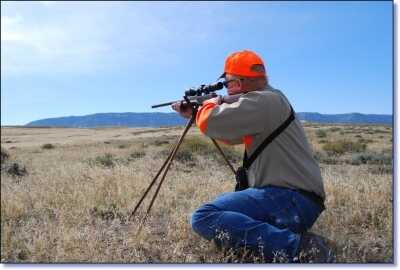
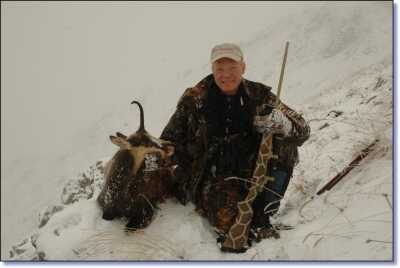
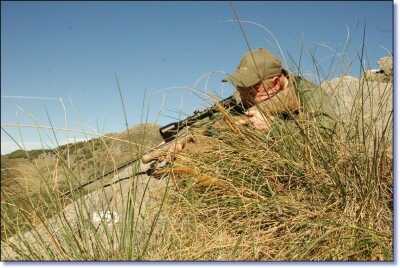
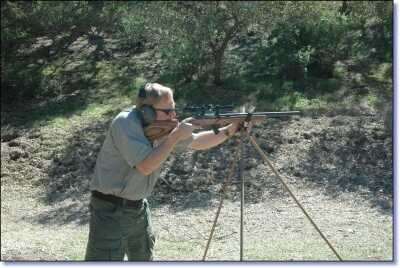
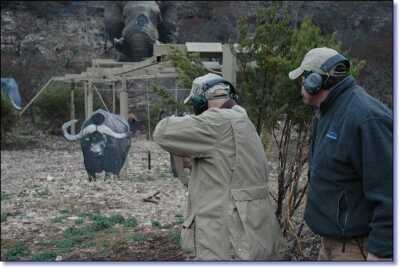
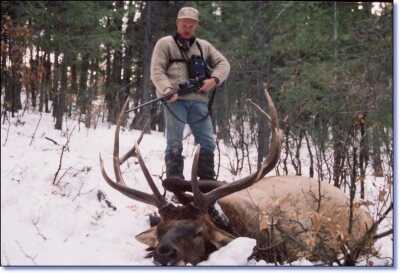
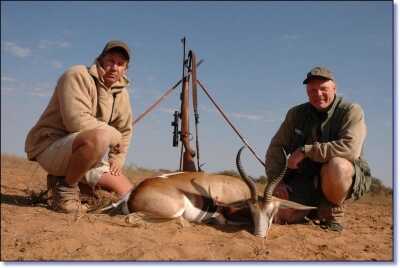
BODDINGTON IS RIGHT ON AS USUAL. WHAT HE TEACH WORKS.